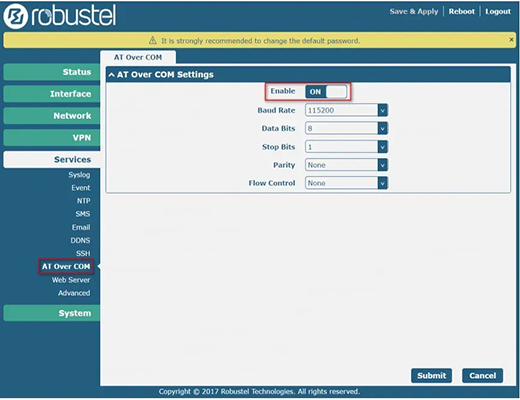
How to use AT Over Com for Industrial Routers
|
|
Time to read 5 min
|
|
Time to read 5 min
In my experience, many engineers rely solely on a router's web interface for configuration.
But there's a more powerful, direct way to control the cellular modem: using AT commands.
This guide will show you how to leverage this foundational tool to unlock advanced functionality on your Robustel industrial router, including remote SMS messaging, status checks, and troubleshooting, all via the serial port.
Let's be clear: when you're working with industrial IoT devices in the field, you need every tool at your disposal. While modern routers offer sleek web GUIs for easy setup, sometimes you need to get down to the brass tacks. That's where AT commands come in. They are a set of basic instructions used to control a modem, originally derived from the "attention" prefix. Think of them as the command-line interface for your cellular module. In my past projects, I've seen countless situations where being able to send a simple AT command via the serial port was the real "aha!" moment that solved a tricky problem. This isn't just about technical flair; it's about reliable, on-the-spot problem-solving that can save you a costly truck roll.
AT over COM is a method for controlling a cellular modem by sending standard AT commands through a serial communication interface, such as a COM port on a PC. This approach gives you direct access to the modem's core functions, bypassing the router's main operating system. It's a foundational technique used by engineers for everything from initial diagnostics to developing custom applications.
This process is a prime example of the kind of granular control that makes industrial-grade routers, like those from Robustel, so valuable. It's not just a black box; it's a fully transparent tool. For instance, using the AT over COM method, you can:
To get started with AT commands on a Robustel router, you'll need to use the "AT Over COM" app. This software module provides the bridge between your modem and the serial port, so you can interact with it directly. For my team, the process usually looks like this:


AT should receive an OK response.
AT+CMGS command, you can send text messages to a predefined number to alert your team of a system event, like an equipment failure or a sensor reading that is out of range.You can also leverage this method for automated applications. For example, a third-party application on a connected computer can use the COM port to send an AT command that triggers a system reboot or changes network settings. This is a crucial capability for mission-critical deployments where manual intervention isn't always possible. The Robustel R5020 Lite is a great example of a router that supports these advanced functions, offering a secure, Linux-based RobustOS and a comprehensive suite of VPNs to protect your data during these operations.
In the world of industrial automation, a lot can go wrong. A simple network hiccup can lead to a costly outage. This is where direct control via the serial port becomes a real asset. My team has used this method to resolve issues without ever having to dispatch a technician to a remote site.
For example, on one project, we had a router that was failing to connect to the network after a power cycle. By connecting to the serial port and sending a few diagnostics commands, we were able to quickly pinpoint a misconfigured APN setting that wasn't visible in the web UI. We were able to fix it in minutes, saving a full day of travel and labor costs. This is the kind of efficiency gain you can get when you treat your router as a powerful, multi-purpose tool, not just a simple network appliance. This level of access and flexibility is why industrial-grade devices are so different from consumer-grade ones, and why they're so integral to the success of IIoT projects.
A: The web GUI is a user-friendly, abstracted interface that simplifies common tasks like setting up a VPN or configuring basic network settings. AT commands provide a raw, direct interface to the cellular modem itself, allowing for deeper diagnostics, troubleshooting, and direct control over modem-specific functions that may not be exposed through the web interface.
A: "AT Over COM" is simply a software application that enables the use of AT commands over a standard serial port. While the commands themselves are not encrypted, the router and its connection can be secured. For instance, using a secure VPN tunnel, like the one offered by the Robustel Cloud Manager Service (RCMS), ensures that all data transmitted over the network is encrypted and secure, even when you are debugging a local issue. This is how you protect your OT network from threats.
A: Absolutely. While modern IoT platforms often use protocols like MQTT for data transmission, AT commands can be a fallback for sending simple data or alerts via SMS. This is particularly useful in low-bandwidth or intermittent connectivity scenarios where a full data session isn't possible. Some devices, like Robustel's EG5120 edge gateways, combine this with powerful local processing to handle a variety of industrial protocols and send filtered data to the cloud.